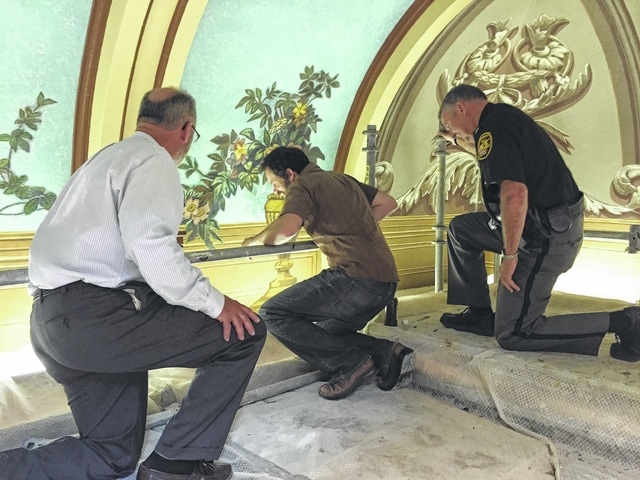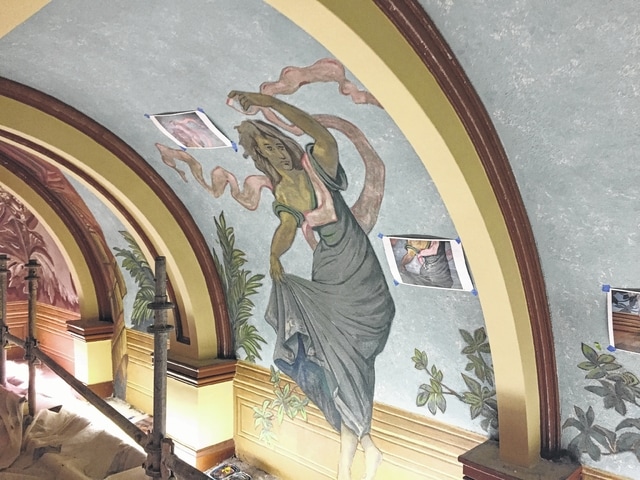

History will open its doors at the Fayette County Court House Sunday in downtown Washington Court House.
Streets of the downtown city will be busy Sunday with the annual Scarecrow Festival in full swing at 1 p.m. with a main stage performance. At that time the historic Fayette County Court House will open its doors to the public for tours and a cook-off will fire up at 2 p.m. on the lawn.
Everyone in the community is invited to come into the courthouse and walk around, learn about its history, the decade-long, $1.2 million renovation that helped to restore its original features, as well as enjoy refreshments and cookies.
The public tour of the court house is in conjunction with the Ohio History Connection in celebration of the 50th anniversary of the National Historic Preservation Act of 1966. The Fayette County Court House is on the National Register of Historic Places for its architecture and three Archibald Willard murals in the main hall that depict the Spirit of Electricity, the Spirit of the Telegraph, and the Spirit of the U.S. Mail.
People walking through the courthouse Sunday will have the opportunity to meet some of the people who work there, learn about the court’s history and significance, and view first-hand the hand-painted floor to ceiling murals and frescoes under a multi-colored stained-glass ceiling.
“It’s a chance for the people to see the completed renovations and restored art work at their own leisure and the court officials will be available to answer questions and discuss the improvements,” said Steven Beathard, Fayette County Court of Common Pleas Judge, who will be at Sunday’s open house.
The renovations began in 2005. Beathard, who was elected as Fayette County Common Pleas judge in 2004, said the original features of the courthouse were in pretty bad shape when he took office.
Renovations ensued: shag carpet was removed to reveal beautiful Italian ceramic tile flooring, wood panels were removed to reveal a door, curtains were taken down, and windows that had been painted over with black paint were cleaned up or replaced.
A wall was removed in the back of the common pleas court room that had been installed with shelved units to make a law library. Tearing down that wall and moving the law library has allowed for more natural light to come into the courtroom, said Beathard.
The floor was updated to model the original theater-style seating and Beathard had benches ordered from Chicago to replace the individual seats that previously occupied the main room.
A Columbus-based company, MuralWorks, owned and operated by Matt Indrutz, provided detail on restoring the historic decorative paintings of frescoes that were in deteriorated condition. Indrutz built scaffolds along the ceiling and the MuralWorks crew worked for more than eight weeks to fix the plaster and re-make the human figures.
Beathard said MuralWorks did unbelievable restoration work of the historic paintings. Beathard said Indrutz would take digital pictures of the original paintings, print them to size, and hang the photos up beside the paintings—as guides to follow to re-master the artwork in precise detail.
The common pleas court administrator, Carmen Baird, said photographs will be on display that show the inside of the building through the decades.
Other renovations included replacement and repair of the ceilings, crown molding, railings, and floors to result in what Tony Anderson, Fayette County Commissioner, said has been a very good project.
“I’m very very satisfied with the money that has been spent and the improvements that have been made, and I’m excited the public is going to have an opportunity to come in and take a look unobstructed,” said Anderson, who said the county put up a couple hundred thousand dollars along with the $1.2 million United States Department of Agriculture grant to help with the improvements and renovations.
He said he couldn’t be happier with the desire of the elected officials in the courthouse to improve the building.
“I am pleased with the requests made with the elected officials inside the courthouse,” said Anderson. “The folks in there are wonderful people who make good suggestions…it goes back to Judge Nancy Hammond—Juvenile Probate judge ahead of David Bender—she was passionate about getting the renovations started.”
Anderson said that not only did Judge Hammond see the value of the updates and modernization of the courthouse, but the other judges followed suit.
“There have been a lot of good things Judge Beathard has put in from his budget, and we just don’t see that kind of cooperation around the state. In other offices, across the state, they are protective of their budgets,” said Anderson, saying that other city’s elected officials are unwelcoming in collaborating on projects such as this in their own communities.
“And Judge Bender has always been as helpful as he can be. I think the public will be pleased with it when they see it,” said Anderson.
Hammond said when the building was erected its source of heat was from the fireplaces, and the air conditioning came from the transoms that opened above the doors to allow the air to circulate.
“Obviously—it was in my mind, anyway—a beautiful building and it had all been designed well and thought out and furniture custom-made. But also, at well over a hundred years old, it was getting more and more difficult for modern conveniences and technology to be superimposed on what was there. There had to be a concerted effort to try to integrate that and preserve the history and the historical beauty of the building and the contents—at the same time accommodating the 21st century,” said Nancy Hammond, who served for 21 years in the building as the Fayette County Juvenile Probate Court Judge before retiring in 2012.
Back when the building was constructed, said Hammond, “Certainly nobody had heard of a computer and all of the electricity, the heating, all of that.”
“But yet,” Hammond said, “you want to preserve the history of the building, the architecture.”



